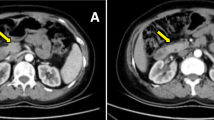Abstract
The 'dependent stomach sign' and 'dependent intestine sign' have been typically described for agenesis of dorsal pancreas. It is useful to differentiate pancreatic agenesis from the fatty infiltration of pancreas which is seen in pancreatic atrophy and pancreatic lipomatosis.
Similar content being viewed by others
Explore related subjects
Discover the latest articles, news and stories from top researchers in related subjects.Avoid common mistakes on your manuscript.
The ‘dependent stomach sign’ and ‘dependent intestine sign’ have been described in relation to agenesis of dorsal pancreas. The normal pancreas consists of the head, uncinate process, neck, body, and tail. Developmentally, the pancreas arises from a dorsal and a ventral anlage. The dorsal anlage gives rise to a part of the head, the entire neck, body, and tail of pancreas, while the ventral anlage gives rise to the remaining head and the uncinate process of the pancreas. In patients with agenesis of the dorsal pancreas, the neck, body, and tail of pancreas are absent [1, 2]. In this condition, the presence of stomach and bowel loops in the distal pancreatic bed, adjacent to the splenic vein, are noted which is called ‘dependent stomach sign’ and ‘dependent intestine sign,’ respectively (Fig. 1).
A Axial contrast CT image showing short and truncated head of pancreas, with the absence of the neck, body, and tail (arrowhead) along with the presence of stomach and bowel loops in the distal pancreatic bed (dependent stomach sign and dependent intestine sign) (arrow). B Axial contrast CT image showing the splenic vein abutting the stomach, and C coronal reformatted CT image showing the course of the splenic vein and its relation with the stomach. The pancreatic head is also seen (asterisk)
Various imaging modalities such as ultrasonography, multidetector computed tomography (MDCT), and magnetic resonance imaging with magnetic resonance cholangiopancreatography are used for the evaluation of the pancreas. With rapid improvement in techniques, MDCT evaluation of pancreas has become a routine procedure with a high diagnostic yield. The ‘dependent stomach sign’ and ‘dependent intestine sign’ are useful to differentiate the fatty infiltration of the pancreas (as seen in pancreatic atrophy as well as pancreatic lipomatosis) (Fig. 2) from agenesis of dorsal pancreas. In the former, abundant fat tissue is seen in the pancreatic bed anterior to the splenic vein without the presence of stomach and bowel loops in pancreatic bed [3]. The presence of this sign signifies pancreatic agenesis, not merely its atrophy or replacement. If the pancreas has been surgically removed, as in distal or total pancreatectomy, the surgical bed is cicatrized and does not contain any bowel loop; therefore, the described signs would not be present [4].
References
Mohapatra M, Mishra S, Dalai PC, et al. (2012) Imaging findings in agenesis of the dorsal pancreas. Report of three cases. JOP 13(1):108–114
Voldsgaard P, Kryger-Baggesen N, Lisse I (1994) Agenesis of pancreas. Acta Paediatr 83(7):791–793. doi:10.1111/j.1651-2227.1994.tb13144.x
Soyer P, Spelle L, Pelage J, et al. (1999) Cystic fibrosis in adolescents and adults: fatty replacement of the pancreas—CT evaluation and functional correlation. Radiology 210(3):611–615. doi:10.1148/radiology.210.3.r99mr08611
Yamauchi FI, Ortega CD, Blasbalg R, et al. (2012) Multidetector CT evaluation of the postoperative pancreas. RadioGraphics 32(3):743–764. doi:10.1148/rg.323105121
Author information
Authors and Affiliations
Corresponding author
Ethics declarations
Funding
None.
Conflict of interest
The authors declare that they have no conflict of interest.
Research involving human participants and/or animals
This article does not contain any studies with human participants or animals performed by any of the authors.
Informed consent
Additional informed consent was obtained from all the individual participants for whom identifying information is included in this article.
Rights and permissions
About this article
Cite this article
Lal, H., Yadav, P. & Mourya, C. Dependent stomach sign and dependent intestine sign of dorsal pancreatic agenesis. Abdom Radiol 42, 667–669 (2017). https://doi.org/10.1007/s00261-016-0911-8
Published:
Issue Date:
DOI: https://doi.org/10.1007/s00261-016-0911-8






